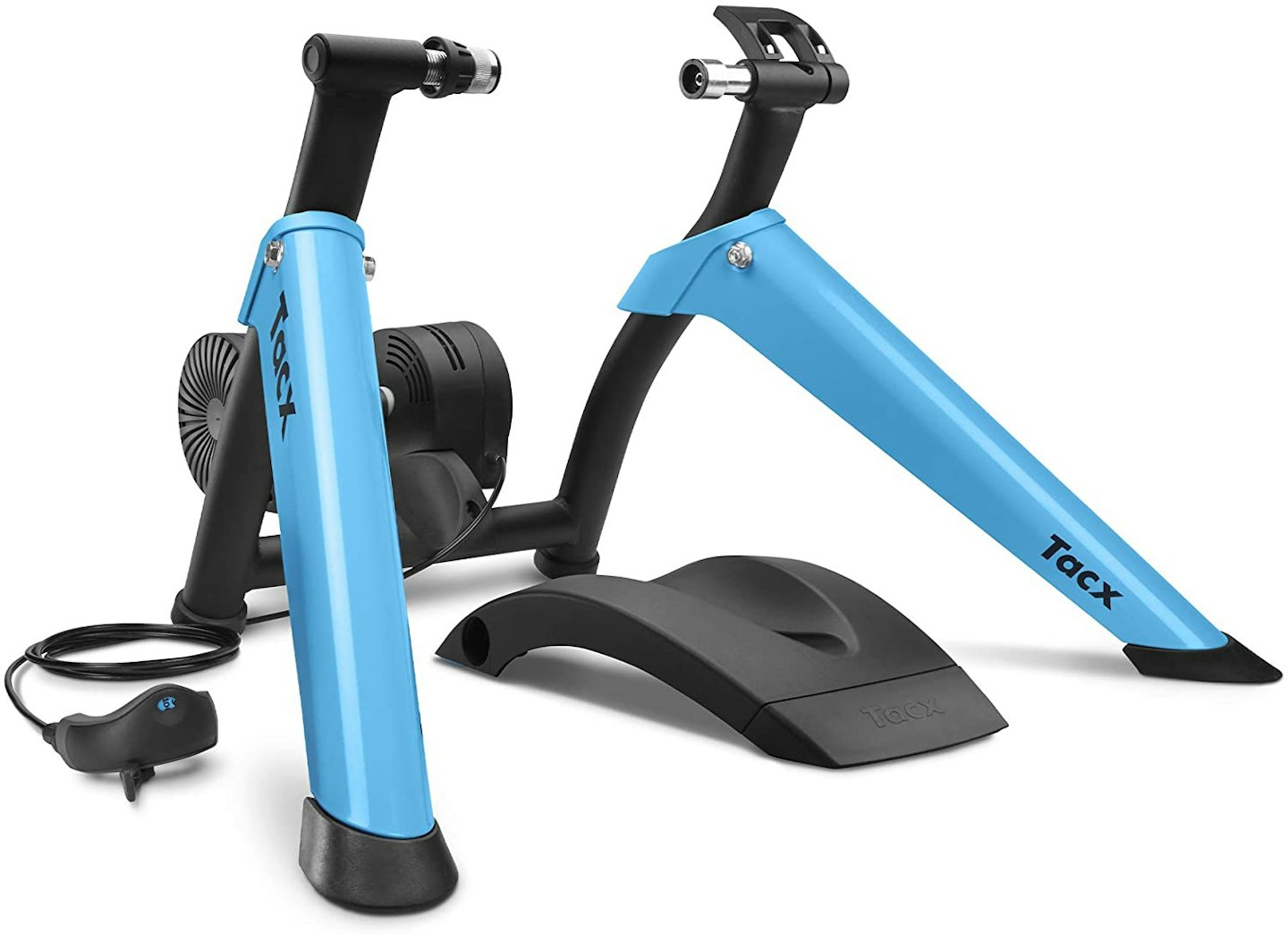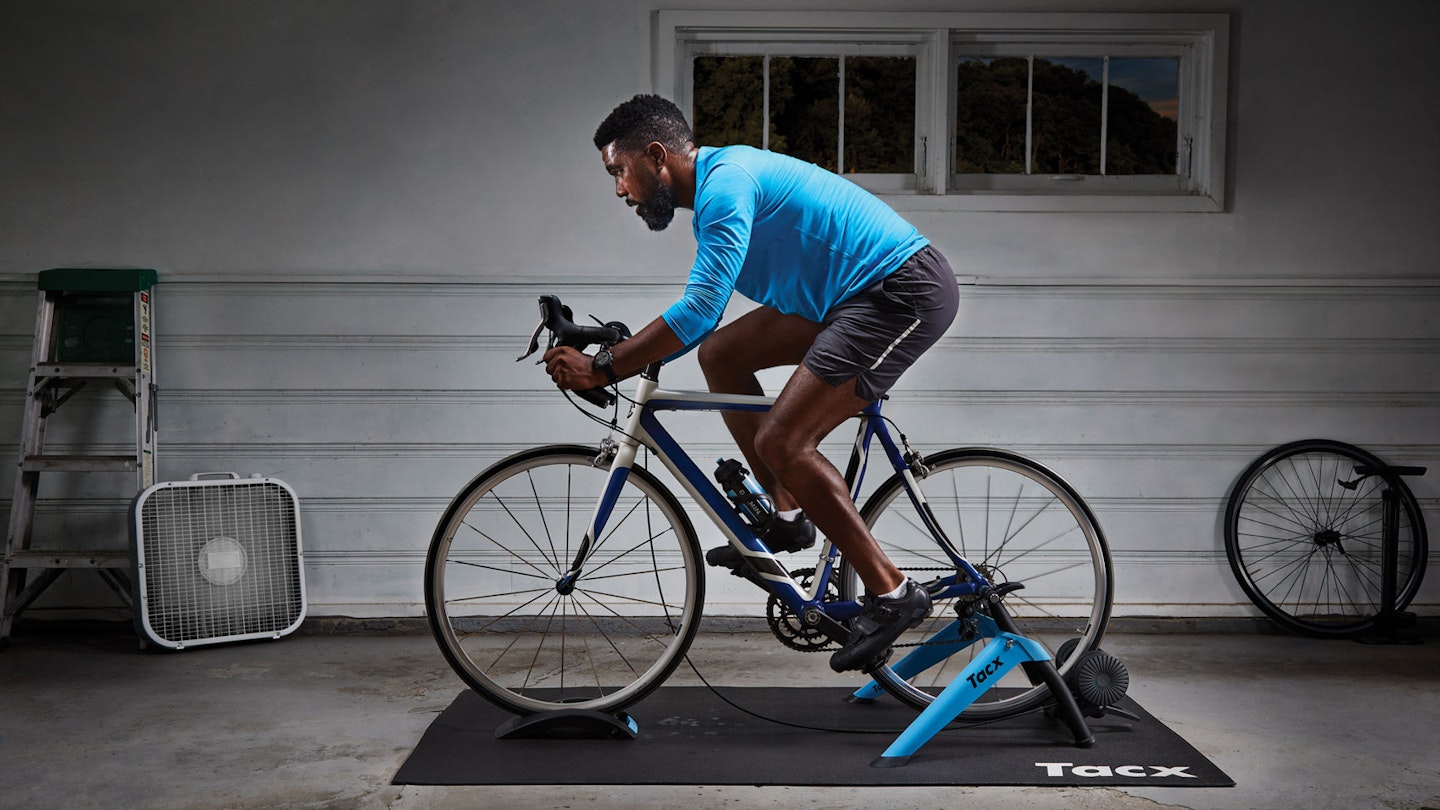Indoor cycle training used to be pretty simple – you hooked your bike up to a turbo or a set of rollers and ground out some hard miles until your legs said ‘no more’. Now there are more choices to consider – smart or dumb trainer, magnetic or fluid-filled, wheel-on or wheel-off, and which of the growing number of training apps you want to use.
Related: Best Turbo Trainers for Zwift
The Tacx Boost is as basic and robust as they come, but does that mean it’s consigned to stepping-stone status before a more sophisticated unit down the line? What’s The Best’s Adam Binnie breaks out the lycra (don’t worry, not photographed) to find out.
| Specifications | |
|---|---|
| Type | Magnetic turbo trainer |
| Resistance | Ten levels |
| Power source | Not needed |
| Max power | 1050W |
| Flywheel | 9.18kg (simulated) 1.65kg (actual) |
| Fits | 26-29” wheel with 5mm QR |
| Kit includes | Boost, front wheel support, quick release skewer |
| Pros | Cons |
|---|---|
| • Small | • Pricey |
| • Quiet | • No smart sensors |
| • Powerful | • Only fits QR axles as standard |
Verdict: An ideal introduction to indoor cycle training with a solid, premium feel to the unit and all the features you’d expect and want. Setting up the distance between the wheel and the roller is crucial but after that, the Boost delivers consistent results.
Some will pretty soon be looking to sell the Boost on, probably after getting hooked on turbo training and mentally trying to justify buying a smart trainer, but for those of you wanting something simple and reliable, it’s all you’ll ever need. Providing you can get past the higher than average ticket price, that is.

Jump to:
Build

• Strong metal construction
• QR clamp grips wheel securely
• Could do with a wider stance
The first thing to talk about in this section is the fact you have to do a bit of assembling before you can use the Tacx Boost.
It’s a simple job really, which requires attaching the magnetic drive unit onto the legs of the trainer, but because the former is quite heavy you might find the process a little fiddly.
You also need to attach it in the correct position for your wheel size and I found this took a bit of trial and error, but you need to get this step right otherwise you won’t be able to clamp the drive unit against your tyre.
It also means you can’t hot-swap between a mountain bike and aroad bike for example, without taking the unit off to realign it. Probably not a problem for most but worth considering if you don’t have a dedicated training bike.
Once you’ve lined everything up though it goes together with two allen bolts using the supplied allen key and then you’re good to go. The only thing to do then is thread the included QR skewer through your rear hub (it’ll be too wobbly if you use the axle on your bike) and clamp it down.
I found this more of a faff than in videos of the Boost I’ve watched, probably more to do with the shape of my bike’s dropouts than anything else, but the process is simple enough. You set the tension with a screw-out adjuster on one side of the turbo and then clamp the handle down on the other side.
Then the distance between the drive unit and the wheel has to be set correctly – which is clearly explained in the manual. On my previous turbo the roller was pressed into the wheel via a big spring, so the ability to fine-tune this on the Boost was welcome.
You're also going to want a fan to keep you cool - I've got one of these and it's excellent:

Usability

• Easier to leave it set up with the bike
• No power supply required
• Additional tech needed for Zwift, etc
Once the bike’s on it’s easiest to leave it that way, I found, rather than take it off and pack the unit away each time. If you are less lazy or space is a concern then it wouldn’t be the end of the world to disassemble it at the end of your ride, because in theory once the various tension adjusters are set you don’t need to touch them again.
For me though I found the Boost took up less space than my old turbo while attached to the bike, but conversely wasn’t as compact when packed up, so it made more sense to just leave it alone.
That said, because the stance of the trainer wasn't as wide as my old one, I did find it rocked side to side a bit, especially when sprinting out of the saddle. I suspect a good exercise mat underneath might stabilise it.
Included in the box is a front wheel chock that you will want to use, because otherwise the rear wheel will be higher than the front, which will feel weird and uncomfortable. This is a sturdy plastic construction with a groove for you wheel, the ideal size for a road bike but likely too narrow for a mountain bike.
There’s also no through-axle compatibility as standard with the Boost, you’ll have to purchase an adaptor separately if you have a bike with anything other than a standard quick-release axle.
Performance

• Lots of resistance on offer
• Reasonable noise levels
• A bit of rear wheel slip from time to time
There are a lot of numbers to digest with the Tacx Boost and while these are helpful for comparison with other units, they’re probably not going to mean much to you and me.
The most pertinent really is the fact the Boost has ten resistance settings that ramp up the difficulty as you go, and to turn the most difficult at a speed of 37mph will require 1050 Watts from your legs. This is the most resistance the Boost can offer up, and in fairness that should be enough for all but the punchiest sprinters.
Under less stressful loads the Boost is pretty quiet, with most of the noise you hear coming from the bike’s tyre and drivetrain. It’s worth getting a proper trainer tyre – you’ll wear through an expensive road one in no time, plus it spits loads of rubber all over your garage floor and in theory makes more noise than a dedicated item.
On that, I noticed a couple of times that the tyre would slip when winding up for a big sprint, which meant I couldn’t always accelerate as explosively as I wanted. I suspect the proper tyre would have helped here.
If you’re using Zwift you’ll need a separate speed and cadence sensor for your bike, but the Boost is listed as a recognised turbo trainer, so in theory if you set it to resistance level two, the power you see on screen is what you’re producing. I didn’t find the workouts any harder or easier to use than any other turbo trainer, which suggests the power curve is pretty accurate.
The flywheel is a simulated 9.18kg and feels quite realistic to road riding when you first spin it up, and accelerates and decelerates smoothly, although your wheel speed will drop off quite quickly when you stop pedalling.
Price

The Tacx Boost is usually for sale at around £230 (although cheaper on Amazon, where stock can sometimes be an issue) which is unavoidably pricey when compared to either of the budget Lifelife turbos (you can have a magneticor a fluidone for less than this).
It’s also not much cheaper than Tacx’s entry-level smart trainer, which is broadly cheaper than buying a non-smart trainer and some sensors.
That said, it’s pretty much in-line with what other more upmarket trainer manufacturers charge, so perhaps we’re being a little harsh in our assessment.
Verdict

• Stylish yet robust turbo trainer
• Ideal for casual use
• Looks and feels very upmarket
Features-wise the Boost doesn’t offer much above and beyond what you’d get in a turbo half the price, but it does look and feel very nice to use, and if you’re leaving it set up inside your house, that could be an important consideration for you.
You also need to consider whether you want to eventually upgrade to a smart trainer, whether it’s wheel on or wheel off, because it might be cheaper to just go straight to that type of turbo in the first place.
Otherwise the Boost is a very nice unit that will suit occasional use, shorter training rides, or somebody who is absolutely not interested in Zwift or other smart training apps. If that’s you, then don’t hesitate.
Score 3.5/5
How we tested it
I used two different bikes on the Tacx Boost, an old 26-inch wheel mountain bike a newer 29-inch wheeled road bike, over the course of about four months.
I'm reasonably new to indoor training but have used a range of smart and non-smart turbos. I ride every other night in a half-hour window between tea time and my kids going to bed, and use training apps like Zwift.
Adam Binnie is the Commercial Content Editor and reviewer for WhatsTheBest, specialising in bikes, fitness, cars, parenting and cooking.
Subscribe to the What’s The Best Newsletter to keep up to date with more of the latest reviews and recommendations from the What’s The Best team.
